On Architecture: 2010 year in review- Lawn and Monticello widen, 'cabin' rises
While private sector construction nearly ground to a standstill in 2010, thanks to that bit of trouble American banks have been having, there were still a few standout additions to our physical world worth noting this year.
UVA's South Lawn
After years of pre-publicity and considerable controversy, UVA's big production number, the $105 million South Lawn Project, opened to much fanfare, but flopped at the box office.
Indeed, as the Hook asked in a cover story on the project, should the grassy area on the South Lawn, just a little longer than a tennis court, qualify as a "lawn"?
What began as a tremendously ambitious project when the University chose visionary architect James Polshek was eventually pared down by cost worries and fears among the UVA Board of Visitors that the design might not be "Jefferson" enough. In 2006, the University parted ways with Polshek and went looking for a new architect, a decision that prompted a protest from UVA's architecture faculty. In 2005, over 30 faculty members signed an open letter condemning the University for perpetuating "faux Jeffersonian architecture" and characterized the direction the design was taking as "apologetic neo-Jeffersonian appliqu©."
When UVA hired California-based Moore Ruble Yudell to design the South Lawn, some faculty threw up their hands.
"This," declared architect and letter signer Jason Johnson after seeing renderings of the new design, which featured familiar pergolas and red-brick columned exteriors, "is a disappointment on every possible level."
After it was finished, University Architect David Neuman defended the project from the mixed reviews. "The South Lawn design was inspired by the integration of site planning, architecture and landscape that characterizes Jefferson's Academical Village," he said, "and we feel this project has been fully successful in living up to that inspiration."
But some faculty members were adamant.
"It's clumsy in its detail, its massing, its materials, its fenestration pattern, its effort to hide its bulk, and its relation to the street," says one A-school faculty member. "On the interior, I look up and down those halls, and I feel as if there is a colonoscopy awaiting me behind every door."
Not everyone, though.
"They did a pretty good job," says UVA architectural historian Richard Guy Wilson. "I think it picks up the palette of the Academical Village, but doesn't mimic it."
Wilson, no stranger to bashing other recent designs, also likes the fact that the South Lawn offers places to gather outside the classrooms, in its light-filled conservatory area and gardens, and on the grassy terrace itself, which he sees as an extension of the experience Jefferson wanted to create on the Lawn.
Indeed, the jewel of the South Lawn–- if there is one–- may be the Conservatory, a semi-circular meeting place between Gibson and Nau Halls, which includes a Starbucks, a grassy courtyard, and seating on three levels.
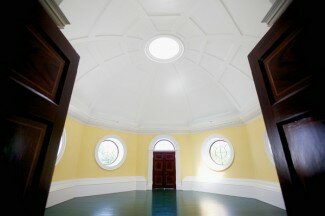 The newly opened Dome Room at Monticello. What was its function? No one knows for sure.
The newly opened Dome Room at Monticello. What was its function? No one knows for sure.FILE PHOTO BY TOM DALY
Monticello
At Monticello, the upper floors of Jefferson's home were finally opened to the public for the first time, including the mysterious third-floor Dome Room. In May, new Monticello boss Leslie Greene Bowman proudly displayed the parts of the residence that Jefferson designed for the enslaved workers who moved about the house relatively unseen, serving food, changing linens, and emptying chamber pots.
In addition to rooms for Jefferson's granddaughters, and two narrow, almost-spiral staircases that allowed slaves to enter all the floors of the house from the basement, Bowman introduced the Dome Room, a beautiful chamber that features a Mars yellow Palladio-inspired “temple” with circular windows and an oculus skylight with beautiful views, but no apparent function.
“It was mostly constructed to be seen from the outside,” said David Ronka, Monticello’s manager of special programs. “But we don’t know what the purpose of the room was.”
It did for a time, however, offer a passage to a secret hiding place for Jefferson's granddaughters, where they could escape the constant activity within the house.
Other changes included a new chrome yellow paint job for the dining room, the color Jefferson had chosen in his later years (after 75 years of Wedgwood blue), the newly renovated wine cellar, and the restoration of the South Pavilion, which served as living quarters for Jefferson and his wife during the two-year construction phase of the main house. All of this accompanied a new exhibit in the cellar level called “Crossroads,” which sheds light on the intersections between Jefferson, his family and guests, and the enslaved workers.
“We’re trying to make Monticello a more lively and entertaining experience,” says Susan Stein, Monticello’s senior curator.
Wood's "cabin on the hill"
That's how developer Wendell Wood characterized the 20,000-plus square-foot residence he was building atop Carter Mountain. However, not only is it one of the biggest houses ever built in the area, it's also perched on the highest part of Charlottesville’s biggest mountain. Indeed, as Wood has now cleared a considerable number of trees around the property, it's hard to miss.
“Have I seen the house?” asked Piedmont Environmental Council officer Jeff Werner. “Who hasn’t?”
While folks like Werner, former County Supe Sally Thomas, and current Supe Dennis Rooker believe the mammoth house is a scar on our mountain viewsheds, for Wood it's the fulfillment of a life-long dream. As a kid, Wood says, he used to ride his bike up there and fantasize about someday calling it home. In 1982 his successes as a real estate developer allowed him to buy the 29-acre tract.With the recent purchase of 272 acres below the mountain along Route 20, he says, he now owns 700 acres of the mountainside.
“This is something I’ve wanted to do for 30 years,” says Wood, 70, resigned to the fact that people have begun to talk about the house. “And I’m not getting any younger.”
Waterhouse
Finally, after five years, it has commenced: architect Bill Atwood's $20 million Waterhouse project, a six-story mixed-use complex of offices, retail space, and apartments atop a parking garage that will span the gap between West Water and South Streets. Demolition began in October.
Originally, Atwood had a vision for a massive pedestrian village, complete with two nine-story towers, an underground parking structure, and a park of sorts that he hoped would “reinvent the block” by rescuing the beauty of the Lewis & Clark building from its isolated perch with a compatible neighbor along the streetscape. But when the economy tanked, so did the vision.
“Fundamentally, the world has changed,” says Atwood, meaning that the money for such creations simply isn't available. “It’s so difficult to get things done these days.”
 The COO Leonard Sandridge looks on as the CEO dedicates his last building.
The COO Leonard Sandridge looks on as the CEO dedicates his last building.FILE PHOTO BY DAVE MCNAIR
Casteen dedicates his last building
One of his goals during his presidency, joked former UVA president John Casteen at the dedication ceremony for Bavaro Hall, the $37 million addition to the Curry School of Education, was to see an open field where Bavaro Hall now stands. “I failed,” he deadpanned. What a card! Of course, the reason everyone chuckled: during Casteen's presidency, UVA built or bought 134 buildings. It was kind of like George Bush saying he always wanted to see Saddam Hussein turn Iraq into an amusement park. Bavaro Hall– executed in neo-Jeffersonianism complete with brick columns and hints of Boston’s Faneuil Hall– transforms a stretch of Emmet Street by blocking the old view of Ruffner Hall.
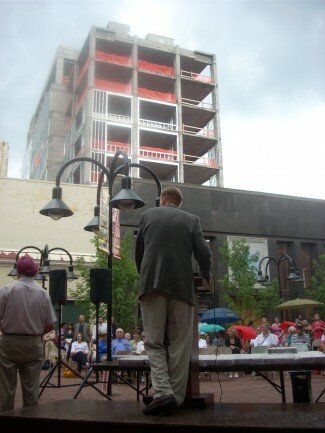 The Landmark looms over the Downtown Mall, and over the reputations of those who promoted it.
The Landmark looms over the Downtown Mall, and over the reputations of those who promoted it.FILE PHOTO BY DAVE MCNAIR
Landmark Hotel
What a mess. What an eye-sore. The abandoned hotel project was actually included in last year's round up, but since it went up two years ago, the 11-story shell of the planned Landmark Hotel continues to loom large over the Downtown landscape, a victim of delusions of grandeur, short-sightedness, hubris, a bad economy, and the ongoing legal battle between Halsey Minor, the hotel’s owner, and Lee Danielson, the hotel’s former developer.
When will it ever get built? Will it ever get built? Unlikely. Since Minor's company Minor Family Hotels LLC declared bankruptcy, the worthless shell of a half-finished building has belonged to the bank that funded its construction, and if they wanted to sell it now, they would most likely have to accept much less than Minor owes them. Earlier this year, it was discovered that some people were squatting on the upper floors of the structure. And as those who've passed by it during heavy rain storms have noticed, it also has the distinction of being Charlottesville's only 11-story urban waterfall.
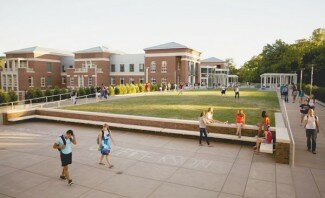
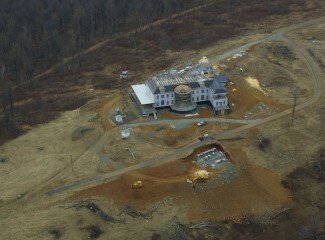
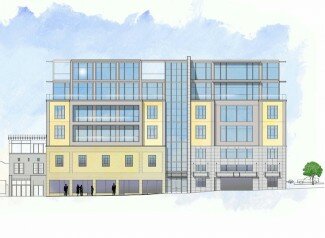
11 comments
Hold on, let me write that down...OK, got it! "Truth, love, peace and sympathy will get me a monster mansion that can be seen from space. Thanx Ken!
To get a clear view of the city, I suppose so.
Nobody cared when Brown's Mountain was cleared off to create magnificent views of the city.
People whine way too much nowadays.
An old indian was explaining human nature to his grandson.
"There are two wolves fighting inside every person. One wolf is jelousy, greed, hate, envy, and prejudice. The other wolf is truth, love, peace and sympathy."
The grandson asked, "grandfather, which wolf wins the fight?"
The grandfather replied, "the one you feed"
Do you have to clear cut a mountaintop to put a house on it. Terrible stuff.
Wood's house, clown house? It will be beautiful when finished!
If he has the desire and money to live in something that large, more power to him!
People with big houses (and big cars) are usually attempting to compensate for other "shortcomings" (ahem).
Macro-Palace = Micro-Phallus...
well pup it worked for carol king, james taylor and jimmy buffet
does wendell think he is in the same league as Jefferson? perhaps he is building his mausoleum. i think planet Earth will not miss him.
The South Lawn looks like Friendship Court. Wood's Cabin on the hill looks like a clown house. The Landmark Hotel? Please....
In my humble opinion the house is attractive.
I know the designer.